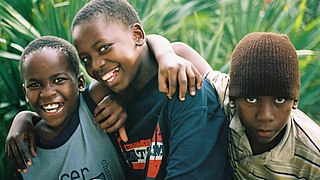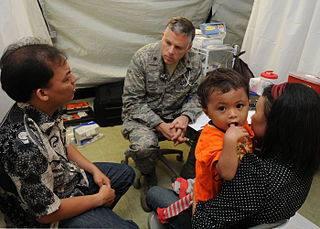Related Research Articles
Occupational therapists (OTs) are health care professionals specializing in occupational therapy and occupational science. OTs and occupational therapy assistants (OTAs) use scientific bases and a holistic perspective to promote a person's ability to fulfill their daily routines and roles. OTs have training in the physical, psychological, and social aspects of human functioning deriving from an education grounded in anatomical and physiological concepts, and psychological perspectives. They enable individuals across the lifespan by optimizing their abilities to perform activities that are meaningful to them ("occupations"). Human occupations include activities of daily living, work/vocation, play, education, leisure, rest and sleep, and social participation.
Social work is an academic discipline and practice-based profession concerned with meeting the basic needs of individuals, families, groups, communities, and society as a whole to enhance their individual and collective well-being. Social work practice draws from liberal arts, social science, and interdisciplinary areas such as psychology, sociology, health, political science, community development, law, and economics to engage with systems and policies, conduct assessments, develop interventions, and enhance social functioning and responsibility. The ultimate goals of social work include the improvement of people's lives, alleviation of biopsychosocial concerns, empowerment of individuals and communities, and the achievement of social justice.
School psychology is a field that applies principles from educational psychology, developmental psychology, clinical psychology, community psychology, and behavior analysis to meet the learning and behavioral health needs of children and adolescents. It is an area of applied psychology practiced by a school psychologist. They often collaborate with educators, families, school leaders, community members, and other professionals to create safe and supportive school environments.

Community health refers to non-treatment based health services that are delivered outside hospitals and clinics. Community health is a subset of public health that is taught to and practiced by clinicians as part of their normal duties. Community health volunteers and community health workers work with primary care providers to facilitate entry into, exit from and utilization of the formal health system by community members as well as providing supplementary services such as support groups or wellness events that are not offered by medical institutions.
School social work is a specialized area of social work concerned with the psychosocial functioning of students to promote and maintain their health and well-being while assisting students to access their academic potential. The School Social Work Association of America defines school social workers as "trained mental health professionals who can assist with mental health concerns, behavioral concerns, positive behavioral support, academic, and classroom support, consultation with teachers, parents, and administrators as well as provide individual and group counseling/therapy."
In social work, a caseworker is not a social worker but is employed by a government agency, nonprofit organization, or another group to take on the cases of individuals and provide them with advocacy, information and solutions. Also, in political arenas, caseworkers are employed as a type of legislative staffer by legislators to provide service to their constituents such as dealing with individual or family concerns. A social worker who works as a caseworker obtains social casework education and training naturally through their compulsory degree works. In social work, casework means to engage a client in learning their situation, to build a suitable plan of action, and helping the client to solve their problems through client commitment and use of their own and community resources, the coordinated service is called case management. British MPs and members of the United States Congress often provide constituent services through caseworkers for better use of their allotted funds.
Personality–job fit theory is a form of organizational psychology, that postulates that an individual's personality traits will reveal insight into their adaptability within an organization. The degree of confluence between a person and the organization is expressed as their Person-Organization (P-O) fit. This is also referred to as a person–environment fit. A common measure of the P-O fit is workplace efficacy - the rate at which workers are able to complete tasks. These tasks are affected by environmental factors within the workplace. For example, a worker who is more efficient working as an individual, rather than in a team, will have a higher P-O fit for a workplace that stresses individual tasks. By matching the right personality with the right job, company workers can achieve a better synergy and avoid pitfalls such as high turnover and low job satisfaction. Employees are more likely to stay committed to organizations if the fit is 'good'.
Psychological resilience, or mental resilience, is the ability to cope mentally and emotionally with a crisis, or to return to pre-crisis status quickly.
The psychosocial approach looks at individuals in the context of the combined influence that psychological factors and the surrounding social environment have on their physical and mental wellness and their ability to function. This approach is used in a broad range of helping professions in health and social care settings as well as by medical and social science researchers.

Forensic social work is the application of social work to questions and issues relating to the law and legal systems. It is a type of social work that involves the application of social work principles and practices in legal, criminal, and civil contexts. It is a specialized branch of social work that focuses on the intersection of law and mental health. Forensic social work is an important part of the criminal justice system and provides an important link between mental health and the legal system.

Refugee health is the field of study on the health effects experienced by people who have been displaced into another country or even to another part of the world, as a result of unsafe circumstances such as war or persecution. People who have been displaced can be affected by infectious diseases or some chronic diseases that are uncommon in the country in which they eventually settle. Mental health is an important consideration and can greatly impact people who are displaced. The health status of refugee's can be tied to factors such as the person who migrated's geographic origin, conditions of refugee camps or urban settings where they lived, and personal, physical, and psychological conditions of the person, either pre-existing or acquired while traveling from their homeland to a camp or eventually to their new home.

Nearly half of all refugees are children, and almost one in three children living outside their country of birth is a refugee. These numbers encompass children whose refugee status has been formally confirmed, as well as children in refugee-like situations.
Social workers employ education as a tool in client and community interactions. These educational exchanges are not always explicit, but are the foundation of how social workers acquire knowledge from their service participants and how they can contribute to information delivery and skill development.
Cultural humility is the “ability to maintain an interpersonal stance that is other-oriented in relation to aspects of cultural identity that are most important to the [person].” Cultural humility is different from other culturally-based training ideals because it focuses on self-humility rather than being an other-directed "they/them" way of achieving a state of knowledge or awareness. It is helpful to see as others see; what they themselves have determined is their personal expression of their heritage and their “personal culture”. Cultural humility was formed in the physical healthcare field and adapted for therapists, social workers, and medical librarians, to learn more about experiences and cultural identities of others and increase the quality of their interactions with clients and community members.

Cultural competence in healthcare refers to the ability for healthcare professionals to demonstrate cultural competence toward patients with diverse values, beliefs, and feelings. This process includes consideration of the individual social, cultural, and psychological needs of patients for effective cross-cultural communication with their health care providers. The goal of cultural competence in health care is to reduce health disparities and to provide optimal care to patients regardless of their race, gender, ethnic background, native languages spoken, and religious or cultural beliefs. Cultural competency training is important in health care fields where human interaction is common, including medicine, nursing, allied health, mental health, social work, pharmacy, oral health, and public health fields.

Special considerations are needed to provide appropriate medical treatment for refugee migrants to the United States, who often face extreme adversity, violent and/or traumatic experiences, and travel through perilous regions. Such considerations include screenings for communicable diseases, vaccinations, posttraumatic stress disorder, and depression.
Healthcare chaplaincy is the provision of pastoral care, spiritual care, or chaplaincy services in healthcare settings, such as hospitals, hospices, or home cares.
The Purnell Model for Cultural Competence is a broadly utilized model for teaching and studying intercultural competence, especially within the nursing profession. Employing a method of the model incorporates ideas about cultures, persons, healthcare and health professional into a distinct and extensive evaluation instrument used to establish and evaluate cultural competence in healthcare. Although the Purnell Model was originally created for nursing students, the model can be applied in learning/teaching, management, study and practice settings, within a range of nations and cultures.
Rehabilitation psychology is a specialty area of psychology aimed at maximizing the independence, functional status, health, and social participation of individuals with disabilities and chronic health conditions. Assessment and treatment may include the following areas: psychosocial, cognitive, behavioral, and functional status, self-esteem, coping skills, and quality of life. As the conditions experienced by patients vary widely, rehabilitation psychologists offer individualized treatment approaches. The discipline takes a holistic approach, considering individuals within their broader social context and assessing environmental and demographic factors that may facilitate or impede functioning. This approach, integrating both personal and environmental factors, is consistent with the World Health Organization's (WHO) International Classification of Functioning, Disability and Health (ICF).
Newcomer education is the specialized teaching of refugees, migrants, asylees and immigrants who have resettled in a host country, with the goal of providing the knowledge and skills necessary to integrate into their country of refuge. Education is the primary way by which newcomers can adjust to the linguistic, social, and cultural environments of their new communities. Newcomer education aims to empower newcomers with a sense of self-efficacy and social integration, as well as giving them the skills to pursue employment or higher education. Newcomer education also aims to help address trauma, culture shock, and other negative effects of forced displacement. Education for newcomers can provide long-term prospects for stability of individuals, communities, countries and global society.
References
- ↑ Lcsw, Jonathan B. Singer, Ph d (December 1, 2008). "Visual Assessment Tools: The Culturagram - Interview with Dr. Elaine Congress".
{{cite web}}: CS1 maint: multiple names: authors list (link) - ↑ "Archived copy" (PDF). Archived from the original (PDF) on 2016-04-18. Retrieved 2016-03-10.
{{cite web}}: CS1 maint: archived copy as title (link) - ↑ "Fordham University". faculty.fordham.edu.